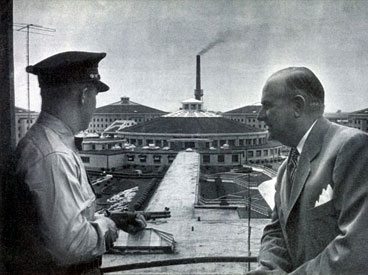
Will we ever get prisons right? Filmmaker Tony Heriza, who spent two years visiting Pennsylvania’s Graterford Prison, the nation’s fourth-largest supermax facility, documented the early years of an ongoing endeavor in which inmates collaborated in the planning, design, and creation of public art for Philadelphia’s Mural Arts Program.
“They became engaged in a creative, collaborative process,” says Heriza, whose film, Concrete, Steel & Paint, has been screened nationwide. “There was also an inside-outside part. Instead of just being isolated and warehoused, they could be productive and visible. These programs, like repairing wheelchairs or training seeing-eye dogs, gives people purpose. It allows them to reconnect with people, and that pushes them to be more self-reflective. You can engage them so they understand the harm they did and give them an opportunity to do some direct or indirect restitution. It’s good not just for people behind bars but for their families and all the lives they touch.”
Throughout the legal and criminal justice world, which includes the professionals who have seen the system continue to fail, there is growing receptivity to the idea of restorative justice—the idea that the criminal justice system has to be predicated on healing and reparation rather than punishment. The notion hearkens back to the ideals of Eastern State’s founders—but without the torture of solitary confinement.
Just ask Bob DeSena of the Council For Unity: “The public thinks that people in prisons are congenital criminals and they think society would be better served by hiring more police and building more cells rather than create programs that would change the dynamic. Yes, there are psychos in prison. But there are also people that could be running companies instead of being in prison.”
Council for Unity organizes incarcerated former gang leaders and gets them together to talk. It’s all voluntary. They sit in a circle and speak freely about their sins and their regrets in a program modeled on AA. “We bring in FBI and Department of Corrections and community stakeholders,” says DeSena, “and they are stunned by the intelligence and depth and squandered assets of young men who should not be in prison.” He argues that the first step in reform is not seeing prisons in isolation but as part of a social system. “We need to recognize that from the moment someone enters prison he needs to be prepared for when he leaves prison. You can’t neglect him for 20 years and have him walk out with $78 and a bus ticket and expect him to function in society.”
DeSena has supporters within and without the system. Sheriff Vincent DeMarco, the warden of Suffolk Jail, recalls his initial skepticism toward DeSena’s proposal to create gang powwows in his prison. “I was like, ‘Who is the guy, what does he want?’ It sounded bogus.” But as DeMarco listened, it began to make sense. “After 20 minutes, I was hooked,” he says. Today, an anti-gang program is running in DeMarco’s jail. “Gang members join voluntarily. They find out that they have more in common than they have different. They are great leaders,” says DeMarco.
Granted, DeSena’s organization has made but a tiny inroad into the gigantic problem of incarceration today. As he points out, what’s needed is a comprehensive reform effort at the government level. “There have to be programs through unions or through tax breaks to corporations for apprenticeships and job placements for offenders. They need halfway houses and wraparound services that include job placement, career readiness, housing, substance abuse services, all the things an offender needs in a communal setting in place before you even let him go. If that happens, he’ll have a place to go, and he’ll have enough here that he doesn’t have to go back there.”
The recidivism DeSena talks about is precisely the problem. It’s widely acknowledged that without programs to lead convicts back to a place in society, we will never cure our nation of its incarceration problem. As a cautionary tale, consider Dickens’ German prisoner, Charles Langenheimer. Released from Eastern State a few years after his encounter with the famous writer, the incorrigible thief would be arrested and jailed at least a dozen more times, serving eight more sentences at Eastern State alone. Finally, in 1884, desperate, frail, and unable to function on the outside, Langenheimer returned to Eastern State and asked if he could be let back in. He said he wished to die in the one place he had successfully adapted to.
Prison officials granted his request.
The Post has covered the question of reform vs. contain in America’s prisons since the 1800s. Check out these articles from our archives, and a more recent video from the Council for Unity, for more on this controversial topic.
Become a Saturday Evening Post member and enjoy unlimited access. Subscribe now



